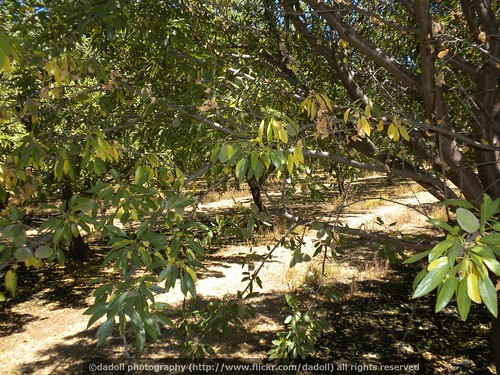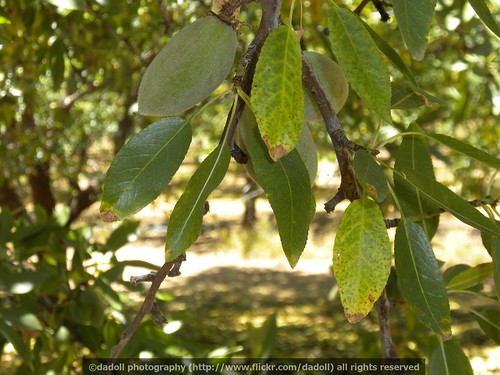During periods of high heat and the corresponding high evapo-transpiration, several unique orchard problems can occur. Most of these are due to fertigation methods which have been widely adopted to increase fertilizer application efficiency. The benefits of fertigation greatly outweigh most negative impacts, but caution must be used as a simple mis-calculation can cause orchard damage.
A field call from a grower in late June demonstrated the potential problems that can occur with fertigation. Observations of yellowing leaves, leaf drop, and death of lower limbs raised concerns by the grower and pest control advisor (PCA), prompting an orchard visit.
Initial Observations:
Upon arriving to the 11th leaf Sonorra/Nonpareil/Carmel (all on Nemaguard) orchard I noticed excessive leaf drop across all varieties (Picture 1). Most of these leaves were coming from the interior of the canopy, suggesting the possibility of drought stress from improper irrigation scheduling. Lower leaves found on the interior of the canopy were burnt back, with a crispy texture. Leaves closest to the trunk that were completely yellow were beginning to abscise, while leaves on the tips of the branches remained green (Picture 2). This is in contrast to lower limb dieback, which causes soft yellow leaves found on the ends of interior branches.

Picture 1: Leaf drop associated with the over-application of potassium thiosulfate.

Picture 2: Leaf wilting and “dieback” associated with the over-application of potassium thiosulfate. Note how the interior branches are more affected than the branches on the outside edge of the canopy.
Up-Close Observations:
Close inspection of the leaves revealed a necrotic tip, or burnt region of the leaf. This leaf was surrounded by a yellow halo (Picture 3). Typically, a yellow halo around a necrotic area would suggest the possibility of almond leaf scorch, but due to the widespread occurrence of the problem, this disease was ruled out. In some leaves, yellow spots, or stippling, occurred throughout the leaf. Again, that pattern of a brown area surrounded by a yellow halo is relevant (Picture 4).

Picture 3: Leaf damage associated with the over-application of potassium thiosulfate.

Picture 4: Close up symptoms of leaf damage. Note the yellow halo and stippling effect on some of the leaf tissues.
Possible Causes:
Since the symptoms were found across the whole field on all varieties, a biological cause was not suspected. Symptoms are most likely caused by an abiotic disorder, which may include underwatering, salt damage, or improper nutrient application (toxicity).
Diagnosing:
Inquiries into the fertilizer program for the orchard revealed the want to “push” the trees for a higher production. By “pushing,” the grower applies more fertilizer more frequently to ensure vigorous growth. Rates of nitrogen fertilization applications seemed to reasonable, with only 6 ounces of actual nitrogen per tree per application being delivered via fertigation. Questioning into potassium revealed that the soil is high magnesium, which makes it difficult to maintain adequate potassium levels. The PCA then revealed that a recent application of potassium thiosulfate was made through the water.
Potassium thiosulfate can cause considerable damage to trees if applied at high rates. I had the PCA check with the grower to confirm the rate of application. The application made was 28 gallons of potassium thiosulfate per acre applied through the microsprinklers. This raised a flag as it seemed to be a large dose to make in one application. Furthermore, due to the fact that it was applied through the microsprinklers, only 70-80% of the orchard floor was irrigated, indicating that a higher rate of around 36 gallons per treated acre was applied to the soil. This rate is too high for a safe, efficient, and effective application of potassium thiosulfate.
A compounding factor was the high temperature and the high evapo-transipration rate. As the tree pulls more water from the soil, it also pulls more water soluble nutrients/salts as well. As these salts enter into the tree and accumulate, they can reach high enough levels and become toxic, killing plant tissues. Orchards have been observed when a nutrient application deemed “safe” in cool weather became toxic in hot weather. This occurs most frequently when applications rate are more on the high side.
Solution/Prevention of Problem:
The evidence suggests that the over application of potassium thiosulfate caused the symptoms on the orchard. The trees should recover naturally, most likely dropping a few more leaves. The crop should be unaffected. In the future, lower rates of nutrients should be applied more frequently when fertigating. Consideration must be made when applying rates that are on the “high side,” as they can become toxic if the tree is in a high water use period.


MAT kinase
July 21, 2009man, you’ve learned a lot about all this fast. haven’t you only been in this position 2 years? i remember us all looking up to the extension guys but you’re catching up to them fast.
The Almond Doctor
July 21, 2009Hey Thanks Matt. I appreciate the comment considering that the amount of information to assimilate is overwhelming. I guess that is why it is nice to have good friends to bounce ideas back and forth…